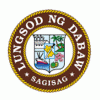Davao City (Davao City)
 |
It is geographically situated in the province of Davao del Sur and grouped under the province by the Philippine Statistics Authority, but the city is governed and administered independently from it. The city is divided into three congressional districts, which are subdivided into 11 administrative districts with a total of 182 barangays.
Davao City is the center of Metro Davao, the second most populous metropolitan area in the Philippines. The city serves as the main trade, commerce, and industry hub of Mindanao, and the regional center of Davao Region. Davao is home to Mount Apo, the highest mountain in the Philippines. The city is also nicknamed the "Durian Capital of the Philippines".
The region's name is derived from its Bagobo origins. The Bagobos were indigenous to the Philippines. The word davao came from the phonetic blending of three Bagobo subgroups' names for the Davao River, a major waterway emptying into the Davao Gulf near the city. The aboriginal Obos, who inhabit the hinterlands of the region, called the river Davah (with a gentle vowel ending, although later pronunciation is with a hard v or b); the Clatta (or Giangan/Diangan) called it Dawaw, and the Tagabawas called it Dabo. To the Obos, davah also means "a place beyond the high grounds" (alluding to settlements at the mouth of the river surrounded by high, rolling hills).
Map - Davao City (Davao City)
Map
Country - Philippines
 |
 |
| Flag of the Philippines | |
Negritos, some of the archipelago's earliest inhabitants, were followed by successive waves of Austronesian peoples. Adoption of animism, Hinduism and Islam established island-kingdoms called Kedatuan, Rajahnates, and Sultanates. The arrival of Ferdinand Magellan, a Portuguese explorer leading a fleet for Spain, marked the beginning of Spanish colonization. In 1543, Spanish explorer Ruy López de Villalobos named the archipelago Las Islas Filipinas in honor of Philip II of Spain. Spanish settlement through Mexico, beginning in 1565, led to the Philippines becoming ruled by the Spanish Empire for more than 300 years. During this time, Catholicism became the dominant religion, and Manila became the western hub of trans-Pacific trade. In 1896, the Philippine Revolution began, which then became entwined with the 1898 Spanish–American War. Spain ceded the territory to the United States, while Filipino revolutionaries declared the First Philippine Republic. The ensuing Philippine–American War ended with the United States establishing control over the territory, which they maintained until the Japanese invasion of the islands during World War II. Following liberation, the Philippines became independent in 1946. Since then, the unitary sovereign state has often had a tumultuous experience with democracy, which included the overthrow of a decades-long dictatorship by a nonviolent revolution.
Currency / Language
| ISO | Currency | Symbol | Significant figures |
|---|---|---|---|
| PHP | Philippine peso | ₱ | 2 |
| ISO | Language |
|---|---|
| EN | English language |
| TL | Tagalog language |
















